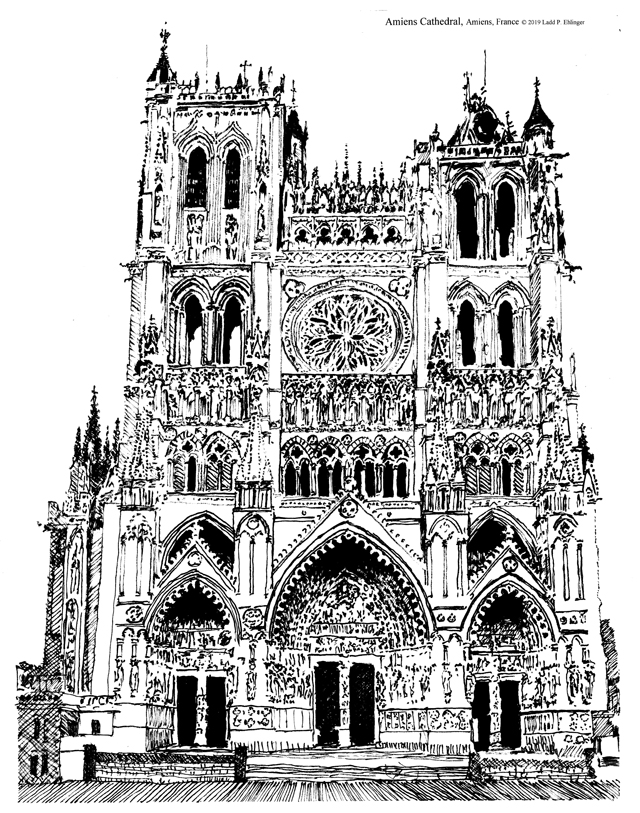
Projects Newsletters Personnel Contact

This issue's sketch by Ladd P. Ehlinger, AIA, is of the west (front) facade of Basilique Cathedrale Notre Dame d'Amiens, or more simply: Amiens Cathedral. There was a previous sketch from the rear and article in the second quarter 1997 E&A newsletter which may be viewed on our website. In the previous newsletter article, most of the history and general information was given in snapshot fashion. Today, we will go into some of the very interesting aspects of the building's faults and corrections and its strange history as a relic repository.
While Amiens is the largest, tallest and most complete Gothic cathedral in France, it suffered from several serious structural flaws that were manifested and corrected over the years. The flying buttresses in the original design around the Choir (east end) were placed too high to resist the lateral thrust being placed on the columns by the groin vaults. Remember that in the 13th Century, mathematical knowledge of statics (the resolution of structural forces in a structure) was non-existent and understood intuitively only.
However, the Master Masons could see the lateral deflection (leaning) of the columns outward at the top, and in effect “feel” what was happening to distort the stone frame. Two centuries after completion, a second, lower set of flying buttresses was added to account for this distortion in the columns due to lateral force. However, this did not fix the distortion being seen in the lower wall which had developed large cracks. Pierre Tarisel, the Master Mason solved this one with a tension member composed of a wrought iron bar chain inserted at the Mezzanine level. The chain was installed when heated red hot, to act as a cinch and shrink when cooled. From 1100 to about 1600, many Gothic churches had similar failures, such as at Beauvais, where its nave, taller than Amiens, collapsed and was never re-built. While these designers could not calculate the stresses and forces, they could intuitively feel how to deal with them. It was only in the 19th Century that the mathematical methods were developed that we use today. In today's world, these issues are solved by finite element software on computer, and it would take a sizeable one at that to solve what was done intuitively in the 12th and 13th Centuries.
During the middle ages because of the Crusades, numerous relics were brought back to European countries from the Holy Land and venerated by pilgrims to various shrines. The purported severed head of John the Baptist, cousin of Jesus, was brought to Amiens on 17 December 1202 as booty from the Fourth Crusade. A reliquary was designed and constructed in the basement of the church, from which the head was removed periodically for display and veneration to pilgrims. The original head was somehow lost, but a 19th Century replica still provides a focus in the North aisle for prayer and meditation.
Amiens Cathedral has been a UNESCO World Heritage site since 1981. It has had recent research that determined the west facade was painted with various colors. The sound and light show has taken this information and caused the Son et Lumiere show to mimic in light the colors that were originally painted, with reportedly spectacular results.
Ladd P. Ehlinger, AIA